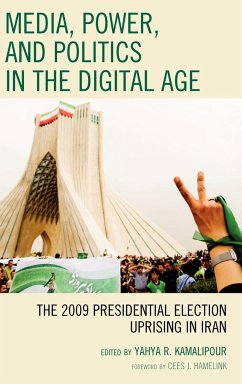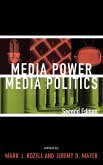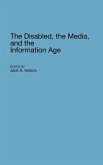Yahya R. Kamalipour
Media, Power, and Politics in the Digital Age
The 2009 Presidential Election Uprising in Iran
Yahya R. Kamalipour
Media, Power, and Politics in the Digital Age
The 2009 Presidential Election Uprising in Iran
- Gebundenes Buch
- Merkliste
- Auf die Merkliste
- Bewerten Bewerten
- Teilen
- Produkt teilen
- Produkterinnerung
- Produkterinnerung
Focusing on the Iranian presidential elections of 2009 and ensuing demonstrations in major cities across Iran and world, Media, Power, and Politics in the Digital Age provides a balanced discussion of the role and impact of modern communication technologies, particularly the novel utilization of "small digital media" vis-à-vis the elections and global media coverage. Written in a non-technical, easy to read, and accessible manner, the volume will appeal to scholars, students, policy makers, and print professionals alike.
Andere Kunden interessierten sich auch für
![Media Power, Media Politics Media Power, Media Politics]() Media Power, Media Politics137,99 €
Media Power, Media Politics137,99 €![The Making of Murdoch: Power, Politics and What Shaped the Man Who Owns the Media The Making of Murdoch: Power, Politics and What Shaped the Man Who Owns the Media]() Tom RobertsThe Making of Murdoch: Power, Politics and What Shaped the Man Who Owns the Media35,99 €
Tom RobertsThe Making of Murdoch: Power, Politics and What Shaped the Man Who Owns the Media35,99 €![Gender, Power, and Communication in Human Relationships Gender, Power, and Communication in Human Relationships]() Gender, Power, and Communication in Human Relationships179,99 €
Gender, Power, and Communication in Human Relationships179,99 €![Power, Media and the Covid-19 Pandemic Power, Media and the Covid-19 Pandemic]() Power, Media and the Covid-19 Pandemic168,99 €
Power, Media and the Covid-19 Pandemic168,99 €![The Disabled, the Media, and the Information Age The Disabled, the Media, and the Information Age]() The Disabled, the Media, and the Information Age88,99 €
The Disabled, the Media, and the Information Age88,99 €![Media Power, Professionals and Policies Media Power, Professionals and Policies]() Howard Tumber (ed.)Media Power, Professionals and Policies113,99 €
Howard Tumber (ed.)Media Power, Professionals and Policies113,99 €![Para-Interactivity and the Appeal of Television in the Digital Age Para-Interactivity and the Appeal of Television in the Digital Age]() Oranit Klein-ShagrirPara-Interactivity and the Appeal of Television in the Digital Age102,99 €
Oranit Klein-ShagrirPara-Interactivity and the Appeal of Television in the Digital Age102,99 €-
-
-
Focusing on the Iranian presidential elections of 2009 and ensuing demonstrations in major cities across Iran and world, Media, Power, and Politics in the Digital Age provides a balanced discussion of the role and impact of modern communication technologies, particularly the novel utilization of "small digital media" vis-à-vis the elections and global media coverage. Written in a non-technical, easy to read, and accessible manner, the volume will appeal to scholars, students, policy makers, and print professionals alike.
Produktdetails
- Produktdetails
- Verlag: Rowman & Littlefield Publishers
- Seitenzahl: 342
- Erscheinungstermin: 16. November 2010
- Englisch
- Abmessung: 235mm x 157mm x 25mm
- Gewicht: 707g
- ISBN-13: 9781442204157
- ISBN-10: 144220415X
- Artikelnr.: 30165456
- Herstellerkennzeichnung
- Libri GmbH
- Europaallee 1
- 36244 Bad Hersfeld
- gpsr@libri.de
- Verlag: Rowman & Littlefield Publishers
- Seitenzahl: 342
- Erscheinungstermin: 16. November 2010
- Englisch
- Abmessung: 235mm x 157mm x 25mm
- Gewicht: 707g
- ISBN-13: 9781442204157
- ISBN-10: 144220415X
- Artikelnr.: 30165456
- Herstellerkennzeichnung
- Libri GmbH
- Europaallee 1
- 36244 Bad Hersfeld
- gpsr@libri.de
By Yahya R. Kamalipour - Contributions by Jonathan M. Acuff; Sareh Afshar; Banu Akdenizli; Rasha Allam; Ibrahim Al-Marashi; Payal Arora; Aliaa Dakroury; Patrick Disney; Mahmoud Eid; David J. Elliott; Mohammed el-Nawawy; Ali Fisher; Elham Gheytanchi; Mahbo
Chapter 1 Foreword
Chapter 2 Introduction
Part 3 PART I: GLOBAL MEDIA DIMENSIONS
Chapter 4 The 2009 Iranian Presidential Election in the Coverage ofCNN and
Al-Jazeera English Websites
Chapter 5 The Canadian Media-Framing of the 2009 IranianPresidential
Election
Chapter 6 The 2009 Iranian Presidential Election in the Polish Media
Chapter 7 Newspaper Coverage of the 2009 Iranian PresidentialElection in
Turkey
Chapter 8 A Comparative Analysis of the Egyptian and IranianPresidential
Elections Media Coverage
Chapter 9 The Presidential Election in Iran 2009: Pre- and PostelectionNews
Coverage in the German Press
Chapter 10 How the Mass Media Defined Iran's Destiny: An GeneralOverview of
the Role of Media Outlets in Iran's June 2009Presidential Election
Chapter 11 Televised Presidential Election Debates: A Brief
ComparativeAnalysis of the American and Iranian Debates
Part 12 PART II: NEW MEDIA AND SOCIAL NETWORKINGDIMENSIONS
Chapter 13 What's That Chirping I Hear? The CNN Effect to the Twitter
Effect
Chapter 14 Bullets with Butterfly Wings: Tweets, Protest Networks, and the
Iranian Election
Chapter 15 Graphic Content: The Semiotics of a YouTube Uprising
Chapter 16 The Role and Impact of New Information Technology
(NIT)Applications in Disseminating News about the Recent Iran Presidential
Election and Uprisings
Chapter 17 The Role of E-diplomacy in Iranian and Xinjiang Riots
Part 18 PART III: IDEOLOGICAL-POLITICAL DIMENSIONS
Chapter 19 Khameni's Group against Khomeini Followers
Chapter 20 Silencing Iran's Twitterati: How U.S. Sanctions Muzzle Iran's
Online Opposition
Chapter 21 Legal Opinion as Political Action: The Significance of Ayatollah
Montazeri's Postelection Fatwa in Delegitimizing the Islamic Republic of
Iran
Chapter 22 Televising the "Velvet Revolution": Show Trials in the Aftermath
of Iran's Tenth Presidential Election
Chapter 23 The Ramadan Controversy: Dilemmas in Mediating between Cultures
through the Study of Dutch and Iranian Media Discourses in the Post-Iranian
Uprising
Part 24 PART IV: CULTURAL AND COMMUNICATION DIMENSIONS
Chapter 25 Faster Than a Speeding Bullet, More Powerful Than a Locomotive:
Mutual Instrumentalization of Culture, Cinema, and Media by Iran and the
United States
Chapter 26 Social Networking Media and the Revolution That Wasn't:A
Realistic Assessment of the Revolutionary Situation in Iran
Chapter 27 Are We Neda? The Iranian Women, the Election, and International
Media
Chapter 28 Symbols, Signs, and Slogans of the Demonstrations in Iran
Chapter 29 Friend or Foe? The Challenges and Tribulations of Iranian
Reporters Working for Western Media
Chapter 30 The Nondiminishing Role of Traditional Media in theCoverage of
the 2009 Iranian Presidential Election:The New York Times versus the New
Media
Chapter 2 Introduction
Part 3 PART I: GLOBAL MEDIA DIMENSIONS
Chapter 4 The 2009 Iranian Presidential Election in the Coverage ofCNN and
Al-Jazeera English Websites
Chapter 5 The Canadian Media-Framing of the 2009 IranianPresidential
Election
Chapter 6 The 2009 Iranian Presidential Election in the Polish Media
Chapter 7 Newspaper Coverage of the 2009 Iranian PresidentialElection in
Turkey
Chapter 8 A Comparative Analysis of the Egyptian and IranianPresidential
Elections Media Coverage
Chapter 9 The Presidential Election in Iran 2009: Pre- and PostelectionNews
Coverage in the German Press
Chapter 10 How the Mass Media Defined Iran's Destiny: An GeneralOverview of
the Role of Media Outlets in Iran's June 2009Presidential Election
Chapter 11 Televised Presidential Election Debates: A Brief
ComparativeAnalysis of the American and Iranian Debates
Part 12 PART II: NEW MEDIA AND SOCIAL NETWORKINGDIMENSIONS
Chapter 13 What's That Chirping I Hear? The CNN Effect to the Twitter
Effect
Chapter 14 Bullets with Butterfly Wings: Tweets, Protest Networks, and the
Iranian Election
Chapter 15 Graphic Content: The Semiotics of a YouTube Uprising
Chapter 16 The Role and Impact of New Information Technology
(NIT)Applications in Disseminating News about the Recent Iran Presidential
Election and Uprisings
Chapter 17 The Role of E-diplomacy in Iranian and Xinjiang Riots
Part 18 PART III: IDEOLOGICAL-POLITICAL DIMENSIONS
Chapter 19 Khameni's Group against Khomeini Followers
Chapter 20 Silencing Iran's Twitterati: How U.S. Sanctions Muzzle Iran's
Online Opposition
Chapter 21 Legal Opinion as Political Action: The Significance of Ayatollah
Montazeri's Postelection Fatwa in Delegitimizing the Islamic Republic of
Iran
Chapter 22 Televising the "Velvet Revolution": Show Trials in the Aftermath
of Iran's Tenth Presidential Election
Chapter 23 The Ramadan Controversy: Dilemmas in Mediating between Cultures
through the Study of Dutch and Iranian Media Discourses in the Post-Iranian
Uprising
Part 24 PART IV: CULTURAL AND COMMUNICATION DIMENSIONS
Chapter 25 Faster Than a Speeding Bullet, More Powerful Than a Locomotive:
Mutual Instrumentalization of Culture, Cinema, and Media by Iran and the
United States
Chapter 26 Social Networking Media and the Revolution That Wasn't:A
Realistic Assessment of the Revolutionary Situation in Iran
Chapter 27 Are We Neda? The Iranian Women, the Election, and International
Media
Chapter 28 Symbols, Signs, and Slogans of the Demonstrations in Iran
Chapter 29 Friend or Foe? The Challenges and Tribulations of Iranian
Reporters Working for Western Media
Chapter 30 The Nondiminishing Role of Traditional Media in theCoverage of
the 2009 Iranian Presidential Election:The New York Times versus the New
Media
Chapter 1 Foreword
Chapter 2 Introduction
Part 3 PART I: GLOBAL MEDIA DIMENSIONS
Chapter 4 The 2009 Iranian Presidential Election in the Coverage ofCNN and
Al-Jazeera English Websites
Chapter 5 The Canadian Media-Framing of the 2009 IranianPresidential
Election
Chapter 6 The 2009 Iranian Presidential Election in the Polish Media
Chapter 7 Newspaper Coverage of the 2009 Iranian PresidentialElection in
Turkey
Chapter 8 A Comparative Analysis of the Egyptian and IranianPresidential
Elections Media Coverage
Chapter 9 The Presidential Election in Iran 2009: Pre- and PostelectionNews
Coverage in the German Press
Chapter 10 How the Mass Media Defined Iran's Destiny: An GeneralOverview of
the Role of Media Outlets in Iran's June 2009Presidential Election
Chapter 11 Televised Presidential Election Debates: A Brief
ComparativeAnalysis of the American and Iranian Debates
Part 12 PART II: NEW MEDIA AND SOCIAL NETWORKINGDIMENSIONS
Chapter 13 What's That Chirping I Hear? The CNN Effect to the Twitter
Effect
Chapter 14 Bullets with Butterfly Wings: Tweets, Protest Networks, and the
Iranian Election
Chapter 15 Graphic Content: The Semiotics of a YouTube Uprising
Chapter 16 The Role and Impact of New Information Technology
(NIT)Applications in Disseminating News about the Recent Iran Presidential
Election and Uprisings
Chapter 17 The Role of E-diplomacy in Iranian and Xinjiang Riots
Part 18 PART III: IDEOLOGICAL-POLITICAL DIMENSIONS
Chapter 19 Khameni's Group against Khomeini Followers
Chapter 20 Silencing Iran's Twitterati: How U.S. Sanctions Muzzle Iran's
Online Opposition
Chapter 21 Legal Opinion as Political Action: The Significance of Ayatollah
Montazeri's Postelection Fatwa in Delegitimizing the Islamic Republic of
Iran
Chapter 22 Televising the "Velvet Revolution": Show Trials in the Aftermath
of Iran's Tenth Presidential Election
Chapter 23 The Ramadan Controversy: Dilemmas in Mediating between Cultures
through the Study of Dutch and Iranian Media Discourses in the Post-Iranian
Uprising
Part 24 PART IV: CULTURAL AND COMMUNICATION DIMENSIONS
Chapter 25 Faster Than a Speeding Bullet, More Powerful Than a Locomotive:
Mutual Instrumentalization of Culture, Cinema, and Media by Iran and the
United States
Chapter 26 Social Networking Media and the Revolution That Wasn't:A
Realistic Assessment of the Revolutionary Situation in Iran
Chapter 27 Are We Neda? The Iranian Women, the Election, and International
Media
Chapter 28 Symbols, Signs, and Slogans of the Demonstrations in Iran
Chapter 29 Friend or Foe? The Challenges and Tribulations of Iranian
Reporters Working for Western Media
Chapter 30 The Nondiminishing Role of Traditional Media in theCoverage of
the 2009 Iranian Presidential Election:The New York Times versus the New
Media
Chapter 2 Introduction
Part 3 PART I: GLOBAL MEDIA DIMENSIONS
Chapter 4 The 2009 Iranian Presidential Election in the Coverage ofCNN and
Al-Jazeera English Websites
Chapter 5 The Canadian Media-Framing of the 2009 IranianPresidential
Election
Chapter 6 The 2009 Iranian Presidential Election in the Polish Media
Chapter 7 Newspaper Coverage of the 2009 Iranian PresidentialElection in
Turkey
Chapter 8 A Comparative Analysis of the Egyptian and IranianPresidential
Elections Media Coverage
Chapter 9 The Presidential Election in Iran 2009: Pre- and PostelectionNews
Coverage in the German Press
Chapter 10 How the Mass Media Defined Iran's Destiny: An GeneralOverview of
the Role of Media Outlets in Iran's June 2009Presidential Election
Chapter 11 Televised Presidential Election Debates: A Brief
ComparativeAnalysis of the American and Iranian Debates
Part 12 PART II: NEW MEDIA AND SOCIAL NETWORKINGDIMENSIONS
Chapter 13 What's That Chirping I Hear? The CNN Effect to the Twitter
Effect
Chapter 14 Bullets with Butterfly Wings: Tweets, Protest Networks, and the
Iranian Election
Chapter 15 Graphic Content: The Semiotics of a YouTube Uprising
Chapter 16 The Role and Impact of New Information Technology
(NIT)Applications in Disseminating News about the Recent Iran Presidential
Election and Uprisings
Chapter 17 The Role of E-diplomacy in Iranian and Xinjiang Riots
Part 18 PART III: IDEOLOGICAL-POLITICAL DIMENSIONS
Chapter 19 Khameni's Group against Khomeini Followers
Chapter 20 Silencing Iran's Twitterati: How U.S. Sanctions Muzzle Iran's
Online Opposition
Chapter 21 Legal Opinion as Political Action: The Significance of Ayatollah
Montazeri's Postelection Fatwa in Delegitimizing the Islamic Republic of
Iran
Chapter 22 Televising the "Velvet Revolution": Show Trials in the Aftermath
of Iran's Tenth Presidential Election
Chapter 23 The Ramadan Controversy: Dilemmas in Mediating between Cultures
through the Study of Dutch and Iranian Media Discourses in the Post-Iranian
Uprising
Part 24 PART IV: CULTURAL AND COMMUNICATION DIMENSIONS
Chapter 25 Faster Than a Speeding Bullet, More Powerful Than a Locomotive:
Mutual Instrumentalization of Culture, Cinema, and Media by Iran and the
United States
Chapter 26 Social Networking Media and the Revolution That Wasn't:A
Realistic Assessment of the Revolutionary Situation in Iran
Chapter 27 Are We Neda? The Iranian Women, the Election, and International
Media
Chapter 28 Symbols, Signs, and Slogans of the Demonstrations in Iran
Chapter 29 Friend or Foe? The Challenges and Tribulations of Iranian
Reporters Working for Western Media
Chapter 30 The Nondiminishing Role of Traditional Media in theCoverage of
the 2009 Iranian Presidential Election:The New York Times versus the New
Media









